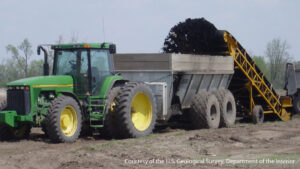Developing and Deploying a Risk Framework for PFAS Management in Rural America
Connecting Predictive Models of PFAS Contamination with Risk Perceptions to Guide Management Decisions
Location: University of Maine
Sponsor: Water Resources Research Institute National Competitive Grants Program (104g)
 This project uses an integrated risk framework to quantify and communicate the threat of PFAS (per- and polyfluoroalkyl substances) contamination to the resilience and livelihoods of rural areas. To achieve this goal, the team is implementing a collaborative, integrated, interdisciplinary research project to address three objectives: 1) identify factors that predict PFAS fate and transport near biosolids agricultural application areas to develop vulnerability models for groundwater (GW) resources; 2) determine barriers to scientific information uptake and implementation of management strategies; and 3) provide a research blueprint for replication of the approach to benefit PFAS-impacted rural communities.
This project uses an integrated risk framework to quantify and communicate the threat of PFAS (per- and polyfluoroalkyl substances) contamination to the resilience and livelihoods of rural areas. To achieve this goal, the team is implementing a collaborative, integrated, interdisciplinary research project to address three objectives: 1) identify factors that predict PFAS fate and transport near biosolids agricultural application areas to develop vulnerability models for groundwater (GW) resources; 2) determine barriers to scientific information uptake and implementation of management strategies; and 3) provide a research blueprint for replication of the approach to benefit PFAS-impacted rural communities.
Across the United States, there is growing concern about the widespread occurrence of PFAS (per- and polyfluoroalkyl substances) in our water, our food, and our bodies stemming from exposure through landfills, pesticides, atmospheric deposition, consumer products and fire suppressants. This is particularly true in rural America, where the land application of municipal and industrial biosolids to agricultural fields or septage disposal sites may be further contributing to PFAS contamination in groundwater (GW) and surface water (SW). Importantly, heavy reliance on private wells for drinking water in these regions drives an urgent need for innovative research to quantify both real and perceived risks and guide management decisions to minimize the threats of PFAS contamination to water resources, rural resiliency, public health, and economic well-being. Understanding the factors that contribute to PFAS fate, persistence and transport in rural areas is essential. However, this information may be insufficient for guiding management decisions and informing stakeholders without concurrent research focused on the individuals and communities whose livelihoods and wellbeing are threatened by this contamination. Many citizens and communities find it difficult to understand the scientific issues involved in complex environmental challenges. Moreover, rural areas consistently display lower trust in scientists and institutions that are responsible for gathering and interpreting data as demonstrated by marked vaccine hesitancy in rural areas during the COVID-19 pandemic. To address the multifaceted nature of the complex challenges that PFAS pose to rural areas, an interdisciplinary team of natural scientists, social scientists, environmental engineers and data scientists is studying the environmental, social, and economic dimensions of PFAS science and management.
The team is integrating unique environmental data sets and employing novel Linear Solvation Energy Relationship (LSER) modeling & machine learning to predict the likelihood that GW in rural areas exceeds PFAS advisory thresholds, thus quantifying risks to rural dwellers. The team is also capturing risk perceptions and potential mitigation actions of rural residents, creating opportunities to improve their understanding of PFAS science and how that science might benefit their community. The project uses an integrated risk framework to quantify and communicate the threat of PFAS contamination to rural areas’ resilience and livelihoods.
Team Members:
Related News and Resources:
- Mitchell Center Talk (4/4/2022) – The Forever Chemicals: PFAS in Maine
- WRRI 104b Project (2021) – Integrated Assessment of Alternative Management Strategies for PFAS-contaminated Wastewater Residuals
- UMaine News (June 2021) – Mitchell Center researchers examine options for managing PFAS
